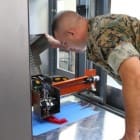CAMP LEJEUNE, N.C. —
The Marine Corps is looking to make additive manufacturing as expeditionary as the operating forces using it.
The X-FAB—which stands for expeditionary fabrication—facility is a self-contained, transportable additive manufacturing lab that can deploy with battalion-level Marine maintenance units. The 20-by-20-foot shelter is collapsible for easier transport, and houses four 3-D printers, a scanner and computer-aided design software system that make quick work of replacement and repair part fabrication.
Marine Corps Systems Command and Marine Corps Installations and Logistics teamed up with machinists from the 2nd Maintenance Battalion at Camp Lejeune, North Carolina, in July to conduct a field user evaluation, or FUE, of a prototype X-FAB. The evaluation will continue through Sept. 1, enabling Marines to test the technology and provide feedback on its capabilities to officials in the requirements and acquisition communities.
“Additive manufacturing is perfectly suited for the machinist community’s mission,” said Ed Howell, program manager for Supply and Maintenance Systems at MCSC. “We don’t know where the technology will take us, but this is a great opportunity to find out what Marines think about it and explore the viability of additive manufacturing for the C7912 Shop Equipment, Machine Shop.”
Shop Equipment, Machine Shop—also known as SEMS—is a deployable shelter equipped with a milling machine, lathe and other tools to quickly repair damaged vehicle parts, weapons and other equipment. The concept is to field X-FAB as a complementary capability for Corps’ intermediate-level maintenance shops that already use SEMS.
In addition to providing an expeditionary additive manufacturing capability, X-FAB can potentially reduce the maintenance battalion’s logistics footprint by eliminating the need to transport large amounts of spare parts, said Master Sgt. Carlos Lemus, staff noncommissioned officer in charge of the Additive Manufacturing and Innovation Cell with 2nd Maintenance Battalion.
“X-FAB will also enable us to better support Marines by getting platforms back in the fight faster,” said Lemus, who took part in the FUE. “We are looking to exploit this capability, because it has the potential to cut out the time it takes to order and receive parts; instead of waiting weeks or a month for a part, our machinists can get the part out by the end of the day.”
X-FAB gives Marines a way to innovate, and make and create their own solutions and ideas—a unique capability that is not available to forward-deployed Marines now, said Lt. Col. Howie Marotto, Additive Manufacturing lead at Marine Corps Installations and Logistics.
“In a contested environment where ships cannot easily land, or airplanes cannot necessarily fly in and deliver goods, Marines need a way to support themselves—at least temporarily,” Marotto said. “The deployable X-FAB would give them another outlet to supply themselves until the regular logistics or supply chain can support them. In some cases, they can even create a capability they didn’t have before, like 3-D-printed drones.”
The X-FAB shelter runs on generator or shore power, and takes a team of four Marines two to three hours to set up. It weighs about 10,500 pounds fully equipped, and for now can be transported via a commercial flatbed truck. Future testing will explore transportability options with Marine Corps vehicles, said Ted Roach, a program analyst in MCSC’s Supply and Maintenance Systems.
Today, X-FAB is purely experimental and exploratory, funded by Department of Defense research and development dollars, Roach said. Throughout the course of the FUE, MCSC will solicit feedback from Marines on everything from the size and layout of the shelter, and capability of the printers and software, to the quality of the printing materials and finished products. That feedback will be used to improve the equipment for future evaluations and inform the acquisition strategy for X-FAB.
Future efforts for X-FAB experimentation will include incorporating it into joint exercises and deploying it aboard ship to explore options for shipboard integration, Roach said.
“We plan to integrate X-FAB into various environments and see what’s within the realm of possibilities,” he said. “With additive manufacturing, you’re only limited by the size of your printer and your imagination.”
By Monique Randolph, MCSC Office of Public Affairs and Communication | Marine Corps Systems Command


